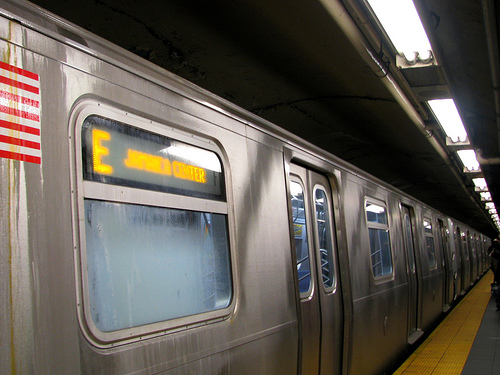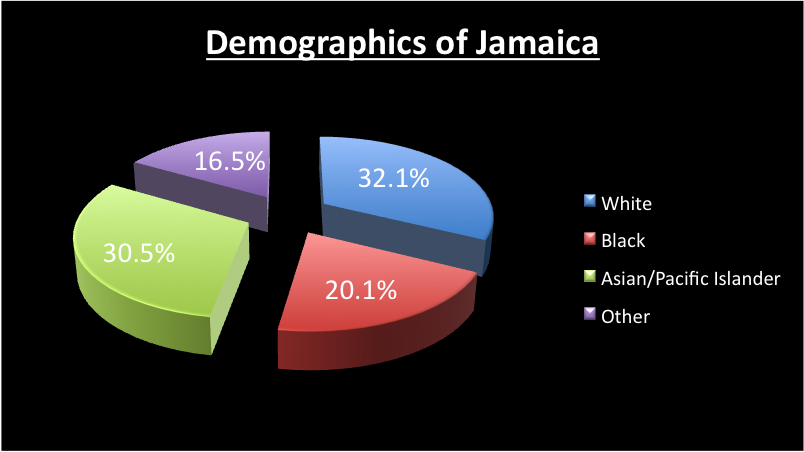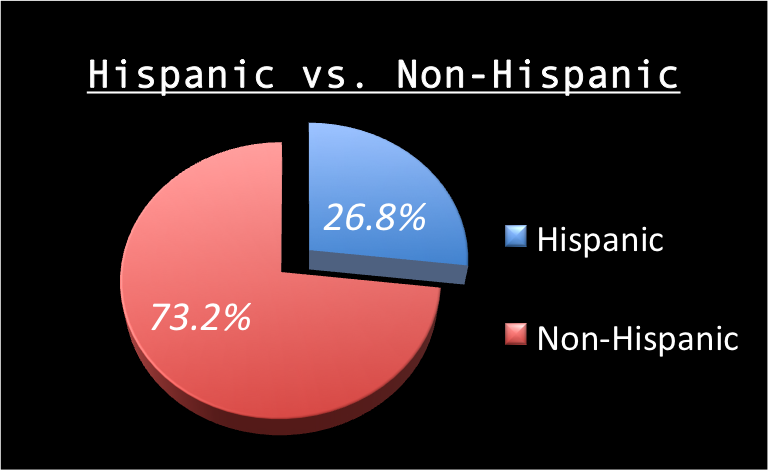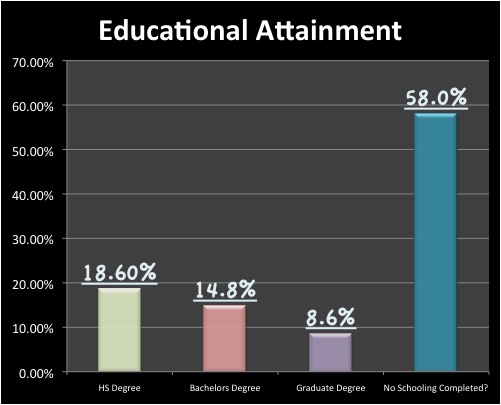Views

View Larger Map
Jamaica is an urban town located in the county of Queens, New York. It may be mistaken for the country of Jamaica by many people, but for those who live in New York, the only Jamaica that we recognize is the Jamaica in Queens. There are many ways to get to Jamaica, if by bus, train or subway, which connects the suburbs and the city of Manhattan with the town of Jamaica. Jamaica is a town that is at the center, connecting Long Island and New York City.
Contents |
Historical Overview
The first inhabitants of the area of Jamaica were the native Indians. It’s not until 1655 that Jamaica came to be settled by Englanders from Hempstead under the grant issued by the governor of New Netherlands, Peter Stuyvesant.[1] As a result of the area being settled or owned by different groups of people, it is clearly understandable that the area went through some name changes as well, for Jamaica wasn’t named as so until years after the first settlers arrived.
The Dutch, first called the area of now Jamaica, Rustdorp, most likely meaning “rest town,” for the areas had such a purpose.[2] When English settlers first came to live in the area, they named the area Rusdorf and later changed the name to Jameco in 1664. Jameco was driven by the name of the Indians who were the first inhabitants of the area,[1]and it also is the Indian word for beaver. The name Jamaica was adopted in 1680, and it is the name people now know the area by.
Not only did Jamaica go through name changes, but the area itself also went through some major changes. When governor Thomas Dongan issued the Dongan Charter, on May 17, 1686, it resulted in the change of dividing the town into small settlements, and issuing the town’s boundaries.[1].As a result of the outbreak of Yellow Fever in the city of Manhattan, Jamaica served as the capital of New York in 1702, even though it was just for a momentary time. Yet Jamaica later came to be a county seat in the year of 1898.[1]
There are still various places in Jamaica that show its great history. Jamaica consists of the Prospect Cemetery, King Manor Museum, Grace Episcopal Church, and Jamaica Avenue. These historical landmarks aren't just primary sources of Jamaica's history, but they have become stepping stones to what the town of Jamaica is today.
Economy and Transportation

| Young World[3] |
|---|
Economic Overview
There were also changes that developed the community and economy of Jamaica to what it is today. At first, Jamaica’s economy derived from being a central trading and bartering system. Yet infrastructure during the 1800s and early 1900s brought about the change of Jamaica becoming more commercial and industrious. Jamaica Avenue used to be a toll road, which connected Hempstead and the Brooklyn Ferry, which made it possible for providing the commerce within the community.[2] The Long Island Railroad also began to establish a connection between Jamaica and Manhattan, providing service for people in both places, and making it easier for traveling as well. Later on electric trolleys, buses and trains began to be developed in Jamaica, connected various parts of Long Island to Jamaica. These developments made it possible for people to go to Jamaica and do their shopping there, making Jamaica the most important place to shop, and in the 1930s, Jamaica also became the place in Queens that had the greatest income.[2] It was in 1930, when the first King Kullen, was opened on Jamaica Avenue. However, in the 1960s, Jamaica started to experience an economic decline, but efforts are still done today, to make Jamaica the center for shopping again.

| E Train [4] |
|---|
Transportation
Besides the change that the infrastructure developments brought to the economy of Jamaica, the developments of transportation also brought in the community entity of the area. Before these changes, it was hard for people to travel from one part of Long Island to another. As of the year 1776, Jamaica's economy was based on agricultural needs. By this time, farmers were trading their products, thus creating a major trading port in Jamaica. Jamaica had a line completed in the year 1834, by the Brooklyn and Jamaica Railroad company. As new ways of transportation started to develop, more people came to visit and reside in Jamaica. Transportation has also helped residents of Jamaica to work in the suburbs or in New York City, and vice versa. These developments have brought about an important change to the overall town of Jamaica.
Forms of Public Transportation[5]
Some of the ways to travel to Jamaica are:
- Q36
- Q42
- Q43
- Q54
- Q56
- F Train
- E Train
- J Train
- Z Train
- The Long Island Railroad(LIRR)
Demographics
With the development of trains, buses and latter subways and airports, various people of different backgrounds, came to visit and even reside in Jamaica. Through these developments are well as others, Jamaica has become more diverse. This increase in the diversity of the people of Jamaica, has also changed the demographics of Jamaica.
The area came to attract many people such as immigrants who came to live in Jamaica during the end of the 1900s. Now, Jamaica is very populated but also has a great diversity for its residents are 73% are of minority groups, and one fifth of that percent are first generation immigrants from countries like China Haiti, Dominican Republic and the Philippines.[2]
Current Demographics[6]


Education
There are various schools located in Jamaica, which include public schools, private schools and colleges/universities. The public schools are part of the New York City Department of Education. Education is important for it helps a person with getting a well-paying job. The higher the education a person receives, the more likely a person will be able to acquire a high-paying job. However, as seen by the graph, the percentage of educational attainment decreases, as a person pursues a higher degree of education.
Current Demographics[7]


Schools[8]
Public Elementary Schools
- PS 131 Abigail Adams (Q131)
- PS 086 Queens (Q086)
- PS 095 Eastwood (Q095)
Public Secondary Schools
- Hillcrest High School (Q505)
- Jamaica High School (Q470)
- Thomas A. Edison Career and Technical Education High School (Q620)
- Queens Gateway to Health Sciences Secondary School (Q680)
Private / Parochial Schools
- Jamaica Day School of St Demet
- Allen Christian School
- Archbisop Molloy High School
- Bethel Mission Junior Academy
- Ideal Montessori School
- Immaculate Conception School
- Jamaica Montessori
- Jamaica Seventh-day Adventist Busy Bee Learning
- New Dawn Elementary School
- Nativity B V M School
- St Clement Pope School
- St Peter Claver School
- St Nicholas of Tolentine School
- The Mary Louis Academy
- United Nations International School
Libraries
- The Central Library:Queens Borough Public Library
Colleges/Universities
- York College
- St. John's University
Conclusion
Jamaica is enriched with a great range of places to explore. Its history can be seen when visiting the Prospect Cemetery and the Grace Episcopal Church. It also has places of attraction like the King Manor Museum and Park, where you not only learn a little about Jamaica’s history, but also get to enjoy the beauty of the place. There is also Jamaica Avenue, where is the place to be for those who love to shop and walk around. In the future, I see Jamaica being the main center for shopping in New York, and that it's economy will thrill once again. Jamaica consists of the old and the new, but it also has a great diversity when it comes to its residents, for its community is made of immigrants and their descendants. I believe that more immigrants will come to reside in Jamaica, making it even more diverse. Wherever in Jamaica one visits, there is always some aspect that attracts attention.
References
- ↑ 1.0 1.1 1.2 1.3 Jamaica Community History." Queens Library. <http://www.queenslibrary.org/index.aspx?page_nm=CL-Communityinfo&branch_id=CEL&#clhistory>.
- ↑ 2.0 2.1 2.2 2.3 "“About Jamaica, Queens, New York City, NY.” CCJ. <http://www.go2ccj.org/jamaica.htm>.
- ↑ "Photos of Jamaica, Queens." About.com:Queens, NY. <http://queens.about.com/od/photogalleries/ig/Photos-of-Jamaica--Queens/>
- ↑ <"E Train to Jamaica, Queens." Flickr. <http://www.flickr.com/photos/dandc/3384244344/>
- ↑ "MTA Home Page." <http://www.mta.info/>
- ↑ "Jamaica, Queens, NY : Data Report." The New York Times. <http://realestate.nytimes.com/community/jamaica-queens-ny-usa/demographics>
- ↑ "Jamaica, Queens, NY : Data Report." The New York Times. <http://realestate.nytimes.com/community/jamaica-queens-ny-usa/demographics>
- ↑ Jamaica Community History." Queens Library. <http://www.queenslibrary.org/index.aspx?page_nm=CL-Communityinfo&branch_id=CEL&#clhistory>

